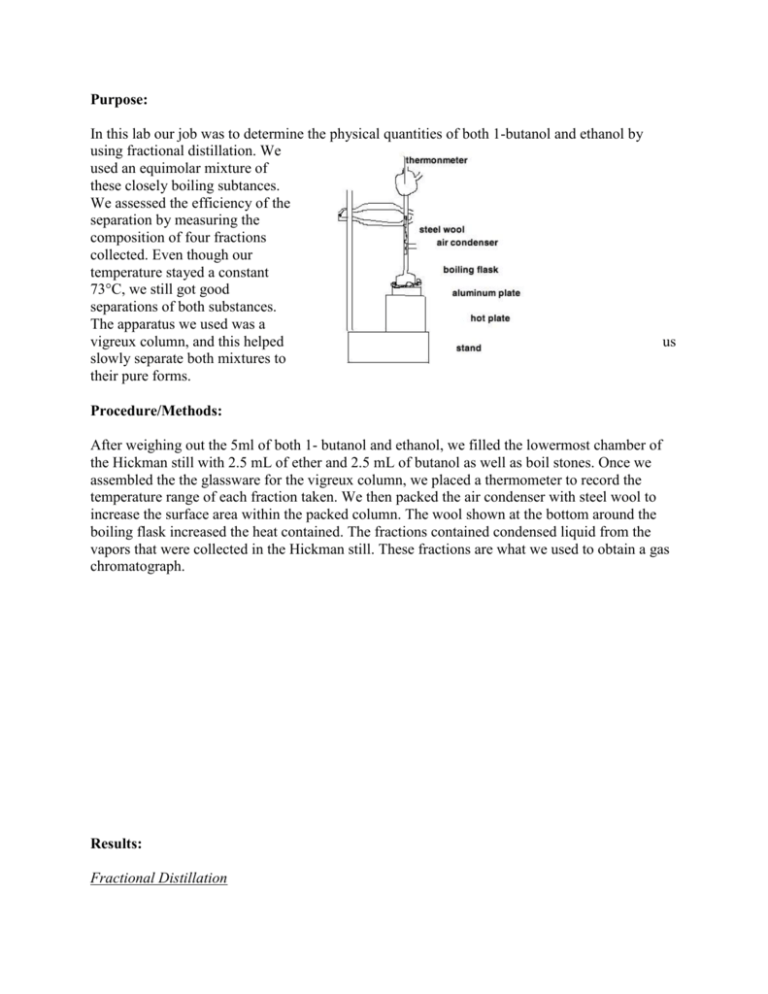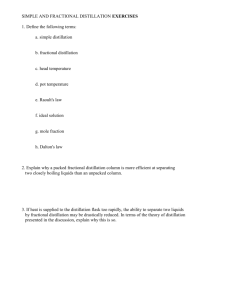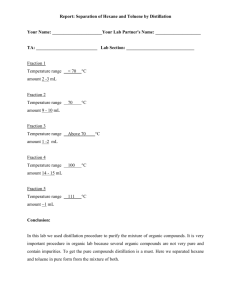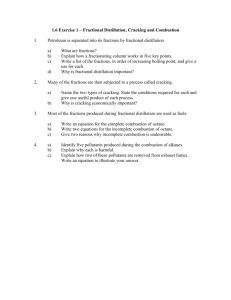Purpose: In this lab our job was to determine the physical quantities
advertisement

Purpose: In this lab our job was to determine the physical quantities of both 1-butanol and ethanol by using fractional distillation. We used an equimolar mixture of these closely boiling subtances. We assessed the efficiency of the separation by measuring the composition of four fractions collected. Even though our temperature stayed a constant 73°C, we still got good separations of both substances. The apparatus we used was a vigreux column, and this helped slowly separate both mixtures to their pure forms. us Procedure/Methods: After weighing out the 5ml of both 1- butanol and ethanol, we filled the lowermost chamber of the Hickman still with 2.5 mL of ether and 2.5 mL of butanol as well as boil stones. Once we assembled the the glassware for the vigreux column, we placed a thermometer to record the temperature range of each fraction taken. We then packed the air condenser with steel wool to increase the surface area within the packed column. The wool shown at the bottom around the boiling flask increased the heat contained. The fractions contained condensed liquid from the vapors that were collected in the Hickman still. These fractions are what we used to obtain a gas chromatograph. Results: Fractional Distillation Figure 1: This was the graph for the first fraction ran via gas chromatography. Ethanol is the only peak shown which means that the first fraction was 100% pure. Figure 2: This is the graph for the second fraction. Here we see that we do not have a pure substance because there are two peaks located. The first peak is ethanol in which the mixture contained 98.84% of this substance. The second peak is 1-butanol in which the mixture contained 1.16%. Figure 3: This is the third fraction in which has a single peak of 1butanol. This is another pure substance. Figure 4: This was our fourth and final fraction taken by gas chromatography and was again pure 1-butanol. Simple Distillation Figure 5: First fraction taken from using simple distillation. The two peaks shown tell us the amounts of 1-butanol and ethanol separated. Figure 6: Section fraction taken, this one showing more ethanol than butanol separated. Figure 7: This is the third fraction taken, again showing the different amounts of 1-butanol and ethanol separated. Figure 8: This was the last fraction taken, showing us that almost all of the 1-butanol has been separated from the ethanol. Simple distillation shows a gradual change of percentages, unlike our fractional distillation. These graphs help show us the difference between fractional and simple distillation. Simple distillation had no pure substance of either ethanol or 1-butanol. On our graphs, you can see three of them are pure and one of them has a mixture of both components. The disadvantage of simple distillation is that you do not get the purest substances you can get. If you want good fractions, you need gradual heating, a long cylinder to slowly capture the pure fractions. The reason we used fractional distillation was because the two components we used we close in boiling temperatures. To use simple distillation, the boiling points have to be greater than a 25°C difference. In fractional distillation, the gas will condense on the surface area of the packing material in the fractionating column, and will be reheated by the rising hot gas, to be vaporized again until it becomes ‘pure’. Contrariwise, simple distillation is often used to separate the liquid substance from the solid substance. Summary: In this lab, we got efficient separations of both 1-butanol and ethanol. We compared our data to our constructors data, who did not use fractional distillation. He used simple distillation, whose fractions are as follows, 90:10 ethanol to butanol, 70:30 ethanol to butanol, 30:70 ethanol to butanol, and 2:98 ethanol to butanol. This shows us the differences between fractional and simple distillation, and teaches us that simple distillation is mainly used when separating solids from liquids, because we did not get completely pure separations like we did with fractional distillation. This seems to indicate that a long path with a packed column gives a better separation.





